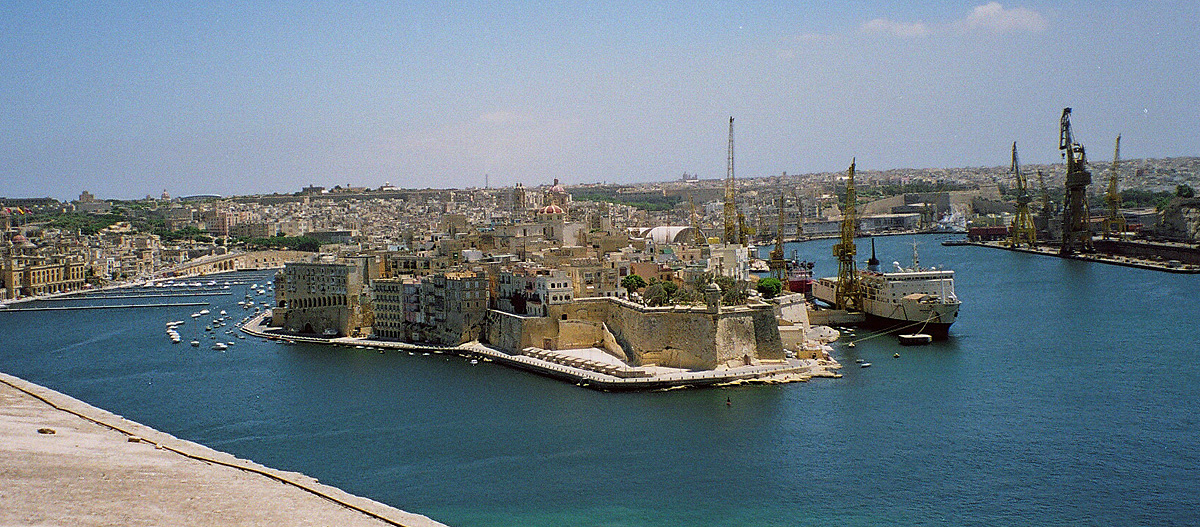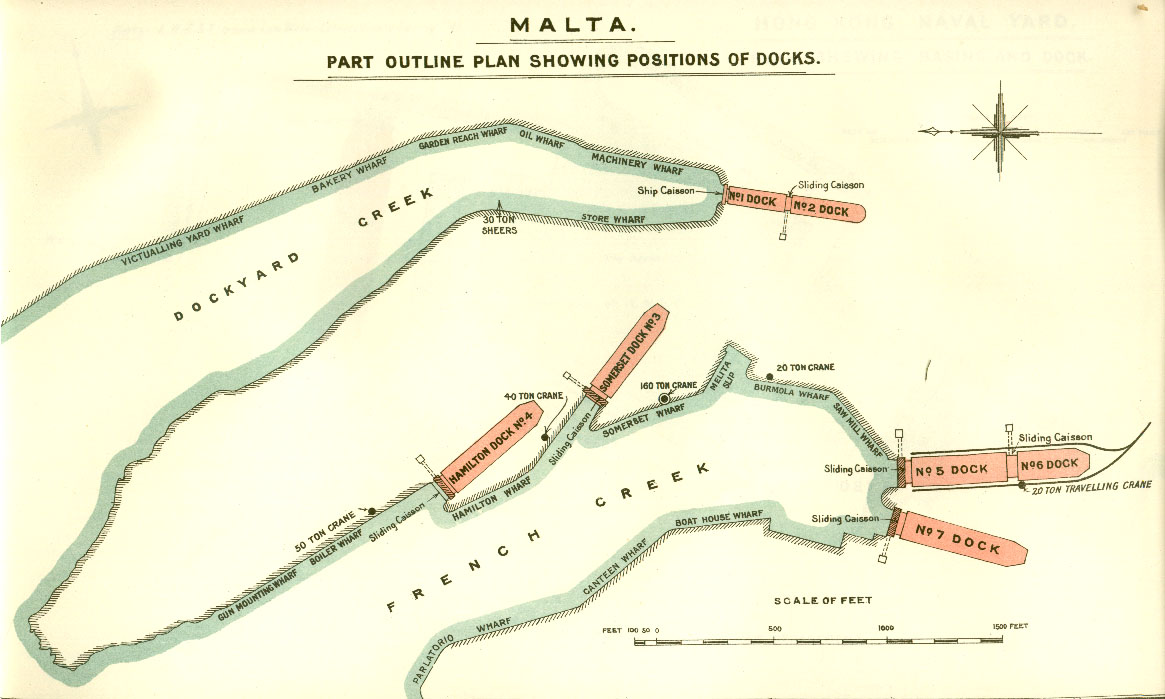Malta Dockyard on:
[Wikipedia]
[Google]
[Amazon]
 Malta Dockyard was an important naval base in the
Malta Dockyard was an important naval base in the
 It was an important supply base during the
It was an important supply base during the
 Malta Dockyard was an important naval base in the
Malta Dockyard was an important naval base in the Grand Harbour
The Grand Harbour (; ), also known as the Port of Marsa, is a natural harbour on the island of Malta. It has been substantially modified over the years with extensive docks ( Malta Dockyard), wharves, and fortifications.
Description
The h ...
in Malta
Malta, officially the Republic of Malta, is an island country in Southern Europe located in the Mediterranean Sea, between Sicily and North Africa. It consists of an archipelago south of Italy, east of Tunisia, and north of Libya. The two ...
in the Mediterranean Sea
The Mediterranean Sea ( ) is a sea connected to the Atlantic Ocean, surrounded by the Mediterranean basin and almost completely enclosed by land: on the east by the Levant in West Asia, on the north by Anatolia in West Asia and Southern Eur ...
. The infrastructure which is still in operation is now operated by Palumbo Shipyards.
History
Pre-1800
TheKnights of Malta
The Sovereign Military Order of Malta (SMOM), officially the Sovereign Military Hospitaller Order of Saint John of Jerusalem, of Rhodes and of Malta, and commonly known as the Order of Malta or the Knights of Malta, is a Catholic Church, Cathol ...
established dockyard facilities within the Grand Harbour to maintain their fleet of galley
A galley is a type of ship optimised for propulsion by oars. Galleys were historically used for naval warfare, warfare, Maritime transport, trade, and piracy mostly in the seas surrounding Europe. It developed in the Mediterranean world during ...
s. These were spread between the cities of Senglea
Senglea ( ), also known by its title Città Invicta (or Civitas Invicta), is a fortified city in the Port Region of Malta. It is one of the Three Cities in the Grand Harbour area, the other two being Cospicua and Vittoriosa, and has a popu ...
, Cospicua and Vittoriosa
Birgu ( , ), also known by its title Città Vittoriosa ('Victorious City'), is an old Fortifications of Birgu, fortified city on the south side of the Grand Harbour in the Port Region, Malta, Port Region of Malta. The city occupies a promontory ...
.
19th century
When Malta became aBritish protectorate
British protectorates were protectorates under the jurisdiction of the British government. Many territories which became British protectorates already had local rulers with whom the Crown negotiated through treaty, acknowledging their status wh ...
in 1800, these facilities were inherited, and gradually consolidated, by the Royal Navy
The Royal Navy (RN) is the naval warfare force of the United Kingdom. It is a component of His Majesty's Naval Service, and its officers hold their commissions from the King of the United Kingdom, King. Although warships were used by Kingdom ...
. With the loss of Menorca
Menorca or Minorca (from , later ''Minorica'') is one of the Balearic Islands located in the Mediterranean Sea belonging to Spain. Its name derives from its size, contrasting it with nearby Mallorca. Its capital is Maó, situated on the isl ...
, Malta swiftly became the Navy's principal Mediterranean base.
The Royal Navy Dockyard
Royal Navy Dockyards (more usually termed Royal Dockyards) were state-owned harbour facilities where ships of the Royal Navy were built, based, repaired and refitted. Until the mid-19th century the Royal Dockyards were the largest industrial c ...
was initially located around Dockyard Creek in Bormla, and occupied several of the dockyard buildings formerly used by the Knights of Malta. By 1850 the facilities included storehouses, a ropery, a small steam factory, victualling facilities, houses for the officers of the Yard, and most notably a dry dock
A dry dock (sometimes drydock or dry-dock) is a narrow basin or vessel that can be flooded to allow a load to be floated in, then drained to allow that load to come to rest on a dry platform. Dry docks are used for the construction, maintenance, ...
– the first to be provided for a Royal Dockyard outside Britain. Begun in 1844, the dry dock was opened in 1847; ten years later it was extended to form a double dock (No. 1 and No. 2 dock).
In the second half of the century the steam factory with its machine shops and foundries was expanded. Very soon, though, it was clear that more space was required than the crowded wharves of Dockyard Creek afforded, to accommodate the increasing size of ships and the increasing size of the fleet based there. The decision was taken to expand into the adjacent French Creek, and between 1861 and 1909 a further five dry docks—three single plus one double dock—were constructed there, along with an assortment of specialized buildings to serve the mechanized Navy.
20th century
 It was an important supply base during the
It was an important supply base during the First World War
World War I or the First World War (28 July 1914 – 11 November 1918), also known as the Great War, was a World war, global conflict between two coalitions: the Allies of World War I, Allies (or Entente) and the Central Powers. Fighting to ...
and the Second World War
World War II or the Second World War (1 September 1939 – 2 September 1945) was a World war, global conflict between two coalitions: the Allies of World War II, Allies and the Axis powers. World War II by country, Nearly all of the wo ...
. In January 1941 sixty German dive bombers made a massed attack on the dockyard in an attempt to destroy the damaged British aircraft carrier , but she received only one bomb hit. Incessant German and Italian bombing raids targeted Malta through March, opposed by only a handful of British fighters. Then in April 1942 the Admiral Superintendent of Malta Dockyard reported that due to German air attacks on Malta's naval base "practically no workshops were in action other than those underground; all docks were damaged; electric power, light and telephones were largely out of action."
The dockyard was handed over to Messrs C.H. Bailey of South Wales, a civilian firm of ship repairers and marine engineers, on the morning of 30 March 1959. At a ceremony the previous day in the Red State Room of the Palace of Valletta, before Navy and civilian officials, the Fourth Sea Lord had handed over a ceremonial key to the Governor of Malta, who had then passed it to the chairman of Bailey. At the time it was intended that "the yard would continue to be supplied with naval repair work, which would diminish as commercial activities expanded." Supervision of residual naval work in the dockyard would be carried out by personnel under the direction of the Flag Officer Malta.
After Baileys were dispossessed by the Maltese Government, by February 1968, the dockyard was closed as a naval base and the Royal Navy
The Royal Navy (RN) is the naval warfare force of the United Kingdom. It is a component of His Majesty's Naval Service, and its officers hold their commissions from the King of the United Kingdom, King. Although warships were used by Kingdom ...
withdrew completely in 1979. It was then managed by a workers' council between 1979 and 1996 repairing civilian ships.
21st century
In 2010, Malta Shipyards Ltd was placed into liquidation and its assets were given over to Palumbo Shipyards. In the course of its government ownership, the dockyard had accumulated €1bn in losses. In 2011, Palumbo acquired on a 30-year lease the neighbouring "superyacht" facility, which includes a drydock with a retractable roof.Administration of Malta Dockyard
The dockyard was initially managed by a Resident Commissioner of theNavy Board
The Navy Board (formerly known as the Council of the Marine or Council of the Marine Causes) was the Regulatory agency, commission responsible for the day-to-day civil administration of the Royal Navy between 1546 and 1832. The board was headqua ...
from 1791 until 1832 when all Resident Commissioners at dockyards were replaced by Superintendents. Admirals Superintendent included:
Resident commissioners
Post holders included: * 1791– 1793 Captain Harry Harmood (co-held title at Gibraltar) * 1793–1796 Captain Andrew Sutherland (co-held title at Gibraltar) * 1801–1803 Captain John Nicholson Inglefield (co-held title at Gibraltar) * 1803–1805 Captain Sir Alexander John Ball (co-held title at Gibraltar) * 1805–1807 Captain William Brown * 1808–1811 Captain William Granville Lobb * 1811–1812 Captain Percy Fraser * 1812–1829 Captain Joseph Larcom * 1829–1832 Thomas Briggs (Admiral Superintendent to 1838)Admiral superintendents
* 1832–1838 Rear Admiral Thomas Briggs * 1838–1843 Rear Admiral John Louis * 1843–1848 Rear Admiral Lucius Curtis * 1848–1853 Rear Admiral Edward Harvey * 1853–1855 Rear Admiral Houston Stewart * 1855–1858 Rear Admiral Montagu Stopford * 1858–1863 Rear Admiral Henry Codrington * 1863–1864 Rear Admiral Horatio Austin * 1864–1868 Rear Admiral Henry Kellett * 1868–1870 Rear Admiral Edward Fanshawe * 1870–1872 Rear Admiral Astley Key * 1872–1876 Rear Admiral Edward Inglefield * 1876–1878 Rear Admiral Edward Rice * 1878–1879 Rear Admiral William Luard * 1879–1882 Rear Admiral John McCrea * 1882–1885 Rear Admiral William Graham * 1885–1887 Rear Admiral William Ward * 1887–1889 Rear Admiral Robert Douglas * 1889–1892 Rear Admiral Alexander Buller * 1892–1894 Rear Admiral Richard Tracey * 1894–1897 Rear Admiral Richard Duckworth-King * 1897–1900 Rear Admiral Rodney Lloyd * 1900–1902 Rear Admiral Burges Watson * 1902–1905 Rear Admiral James Hammet * 1905–1907 Rear Admiral Arthur Bromley * 1907–1910 Rear Admiral Frederic Fisher * 1910–1912 Rear Admiral Ernest Simons * 1912–1914 Rear Admiral Sackville Carden * 1914–1916 Rear Admiral Arthur Limpus * 1916–1918 Rear-Admiral George Ballard * 1918–1921 Rear Admiral Brian Barttelot * 1921–1924 Rear Admiral John Luce (Rear-Admiral in Charge, Malta, and Admiral Superintendent, Malta Dockyard) * 1924–1926 Rear Admiral Charles Johnson (Rear-Admiral in Charge, Malta, and Admiral Superintendent, Malta Dockyard) * 1926–1928 Rear Admiral Alexander Campbell (Rear-Admiral in Charge, Malta, and Admiral Superintendent, Malta Dockyard) * 1928–1931 Rear Admiral Francis Mitchell (Rear-Admiral in Charge, Malta, and Admiral Superintendent, Malta Dockyard) * 1931–1934 Rear Admiral Matthew Best (Rear-Admiral in Charge, Malta, and Admiral Superintendent, Malta Dockyard) * 1934–1937 Vice Admiral Sir Wilfred French (Rear-Admiral (later Vice-Admiral) in Charge, Malta, and Admiral Superintendent, Malta Dockyard) * 1937–1941 Vice Admiral Sir Wilbraham Ford (Vice-Admiral in Charge, Malta, and Admiral Superintendent, Malta Dockyard) ''From 1941-1945 the post of Superintendent, H.M. Dockyard was separated from that of Flag Officer-in-Charge, Malta'' * 1941-1943 Rear Admiral (ret.) K. H. L. Mackenzie (Naval Superintendent, Malta Dockyard) * 1943-1945 Rear Admiral (ret.) P. K. Kekewich (Naval Superintendent, Malta Dockyard)Flag Officer-in-Charge, Malta
* 1941–1942 Vice Admiral Sir Ralph Leatham * 1942–1943 Vice Admiral Sir Stuart Bonham Carter * May–Oct 1943 Vice Admiral Arthur PowerVice Admiral, Malta and Flag Officer, Central Mediterranean
* 1943–1945 Vice Admiral Sir Louis Hamilton * 1945–1946 Vice Admiral Sir Frederick Dalrymple-HamiltonFlag Officer, Malta
* 1946–1948 Rear Admiral Marcel Kelsey * 1948–1950 Rear Admiral Philip Clarke * 1950–1952 Vice Admiral Sir Geoffrey Hawkins * 1952–1954 Rear Admiral Jocelyn Salter * 1954–1957 Rear Admiral Wilfred Brittain * 1957–1959 Vice Admiral Sir Charles Madden * 1959–1961 Rear Admiral Derick Hetherington * 1961–1963 Rear Admiral Viscount Kelburn :''Note: The post was vacant between 1963 and 1967'' * 1967–1969 Rear Admiral Dudley Davenport * 1969–1971 Rear Admiral Derrick Kent * 1971–1973 Rear Admiral John Templeton-Cotill * 1973–1975 Rear Admiral David Loram * 1975–1979 Rear Admiral Sir Nigel CecilGallery
References
Sources
*Macintyre, Donald, The Naval War Against Hitler, New York: Charles Scribner's Sons, 1971 {{coord, 35.879, N, 14.516, E, display=title Royal Navy dockyards Cospicua Senglea Birgu Military installations of Malta Malta–United Kingdom military relations Ports and harbours of Malta